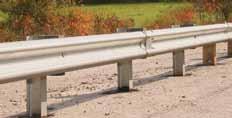
10 minute read
Integrated sustainable planning for infrastructure and public works
Advertisement
Colin Doyle, P.Eng.
Director of Engineering District of Saanich, British Columbia Member, APWA Center for Sustainability n innovative, sustainable adventure has begun in the communities of Saanich, Victoria and Oak Bay in the core of the Capital Region on Southern Vancouver Island, British Columbia, Canada. The Bowker Creek watershed, home to 30,000 residents in the core of the region, has been highly impacted by urbanization and large parts of the watershed are ripe for redevelopment. The Bowker Creek Initiative (BCI), a multi-stakeholder, inter-municipal and community partnership, has developed the Bowker Creek Blueprint: A 100-year action plan to restore the Bowker Creek watershed (2010), a visionary plan which details watershed and reach-specific actions to rehabilitate the creek channel and improve the functioning of this developed watershed over the long term and as redevelopment opportunities arise. Blueprint is a first-of-its-kind opportunistic plan to restore an urban watershed over the long term; it lays out principles of integrated watershed management (IWM) and outlines watershedwide and reach-specific actions to restore the watershed through the process of redevelopment over the next few decades. (See www. bowkercreekinitiative.ca to view the Blueprint.) Recently accepted by the three municipalities, the implementation of the Bowker Creek Blueprint has begun and it proves to be a sustainable journey to restore hydrologic function to the watershed and create economically vibrant, climate-adapted, multi-modal communities linked together with a restored creek and improved community amenities. The District of Saanich, which is located in the upper part of the watershed, is undertaking a major planning process along the highly urbanized, heavily travelled Shelbourne Street. Hidden beneath, confined within large stormwater pipes, runs Bowker Creek. This long-term urban planning process for a significant part of the Bowker Creek watershed provides the District of Saanich with an excellent opportunity to incorporate key aspects from the Bowker Creek Blueprint into the Shelbourne Valley corridor planning process. With a clear vision and Blueprint in place, municipalities and communities are able to incorporate efforts into operational work plans, volunteer and school group efforts and to work together with the development community to restore Bowker Creek and its watershed within a vibrant and active community.
The Bowker Creek Watershed
The Bowker Creek watershed, in the Capital Regional District, on Vancouver Island, is a highly urbanized watershed that has evolved over the past 200 years
The Bowker Creek watershed as seen from Mt. Tolmie, British Columbia
to its current mix of residential, commercial and institutional uses. Home to about 30,000 residents, the Bowker Creek watershed spans the municipalities of Saanich, Victoria and Oak Bay. The creek flows from its headwaters at the University of Victoria, through the three municipalities, at times flowing through natural areas with tree-covered banks and at other times through pipes or hardening channels, to its mouth where it enters the ocean in Oak Bay. Today, more than half (56%) of the watershed is covered with impervious surfaces and less than 40% of the 9.4 km creek remains above ground. Flooding, water pollution, increased impervious surfaces, and habitat loss are key concerns within the watershed. Despite these challenges, the Creek provides a focus for a greenway corridor through Victoria and has the potential to create more vibrant neighbourhoods, while reducing greenhouse gas emissions and adapting to climate change. It has become a pilot area for integrated urban watershed management in the Capital Region.
The Bowker Creek Initiative (BCI)
Established in 2004, the Bowker Creek Urban Watershed Renewal Initiative is a collaborative, multijurisdictional effort that brings together local governments, community groups, post-secondary institutions, developers and private citizens around a common goal of managing and restoring the watershed and creek corridor over the long term.

The BCI is responsible for implementation of Bowker Creek Watershed Management Plan (BCWMP) which was developed in 2002 by a forum of municipal representatives, community organizations, and residents, and
Bituminous Road Oil & Asphalt Emulsifier
CLEAN IT UP
Your job's not complete until your equipment is clean.
Make your life easier — Melts away asphalt and bituminous road oils used in paving, road oiling, chip-seal, slurry-seal, and seal-coating operations.
Equipment versatility — Keep your vehicles, asphalt oil distributors, paving machines, compactors, striping equipment, cones, barrels, barricades, and concrete curbing looking their best!
Environmentally responsible — 100% biodegradable; more aggressive than diesel and safer to use.
Easy, application process — Clean in just minutes! Use a light coating on tools to prevent asphalt sticking and build-up.
RHOMA-SOL is trusted by over TM 30 DOT's and used by hundreds of municipalities, counties and contractors nationwide.
Save thousands of dollars simply by using RHOMAR product solutions to clean and protect the equipment you already have in your fleet.
PROTECTION PRESERVATION PERFORMANCE
www.rhomar.com solutions@rhomar.com
approved by the municipalities of Saanich, Oak Bay and Victoria, and by the Capital Regional District Board (CRD) in 2003. They are guided by the BCWMP vision which is that “the varied uses and natural areas in the Bowker watershed are managed to minimize runoff and pollution, making Bowker Creek a healthy stream that supports habitat for native vegetation and wildlife, and provides a community greenway to connect neighbourhoods.”
As implementation of the BCWMP proceeded, municipal staff found
that even with the vision and the management plan, they were still missing the details of how to achieve that vision particularly when dealing with redevelopment on a lot-bylot basis. They knew that the plan called for a community greenway and restoring the creek, but there was no detail on where the greenway should go or what restoration work was needed. The lack of a comprehensive and holistic vision of what the community wanted the watershed to look like in 100 years, and a plan to get there, meant that opportunities were being missed, one lot at a time. The BCI partners decided that a more consolidated plan that integrated the engineering, planning and environmental, and social requirements into a holistic vision would improve achievement of the BCWMP, and the creation of the Bowker Creek Blueprint began.
The Bowker Creek Blueprint
The Bowker Creek Blueprint is a “100-Year Action Plan,” developed by the BCI to guide watershed and creek corridor restoration as the built environment is redeveloped over time. Because change can be slow in the urban environment, implementation of the plan will take decades. The Blueprint gives the community a road map for achieving water sustainability in an urban watershed. The Bowker Creek Blueprint provides the general “how to” and “where to” guidance to assist municipal staff, developers and the community in achieving the vision of restoring the watershed over the long term. The Blueprint moves past the motherhood statements contained in most management plans to concrete on the ground actions. Bowker Creek Blueprint deals with flooding, water pollution and habitat loss the creek has suffered due to urbanization, while also embedding climate adaptation and mitigation into the integrated actions.
Why 100 years?
It took 100 years to put Bowker Creek in pipes and concrete channels. It will take another 100 years to daylight and bring life back to Bowker Creek. Acknowledging the 100-year timeframe of the Plan in the title of the document gave municipalities much more comfort, and reassurance that they don’t have to act immediately on everything in the Blueprint. Municipalities could endorse the long-term implementation of the plan without being held to spending a specific amount of money over



SKT/FLEAT End Transitions NatureRail® Scenic Guardrail System TTMA-100 Trailer Mounted Attenuator
COMPREHENSIVE HIGHWAY SAFETY SOLUTIONS

For more information, call us today at 330-477-4800 or visit our website at
www.gregorycorp.com
SAFENCE® High-Tension Cable Barrier
Gregory Mini-Spacer Guardrail to Post Hardware Highway Guardrail Full Line Manufacturer


the short term. The idea was not to deflect responsibility and do nothing for the next 10 years; rather, once the Blueprint was endorsed by councils, staff were able to incorporate the Blueprint actions and recommendations into operational work plans as priorities and resources permit. Having a long-term visionary plan in place also provides an opportunity to work directly with the development community to achieve opportunities presented in the Blueprint during the next phase of redevelopment.
The Blueprint is intended to be implemented over a period of decades, because it recognizes that change can be slow in an urban environment. However, several key short-term actions were identified to help ensure that the results of the Blueprint become embedded in other documents pertinent to the region, and that aspects of the Blueprint become part of the way that member municipalities do business. One such action was the planning process for the redevelopment plan for the Shelbourne Valley corridor.
Shelbourne Valley Planning Process
Many areas of the watershed are ripe for redevelopment as the housing stock begins to turn over and many businesses in the commercial sector are redeveloping. The District of Saanich is currently developing a major 50-year plan for the redevelopment of Shelbourne Valley Corridor. This timely process offers an excellent opportunity for the District of Saanich to provide leadership and expertise through the use of visionary planning, “green streets” and innovative stormwater and traffic management techniques to demonstrate how the Bowker Creek Blueprint can be implemented over the next century. Through the upcoming 25-50 year planning cycle, Saanich and the development community have an opportunity to implement intense low-impact development along this high-density traffic corridor, to facilitate safe cycling and pedestrian routes, traffic calming, green streets and boulevard rain gardens and other actions designed to gradually improve the hydrological functioning of the watershed over the next couple of decades as this area redevelops. They can also begin to work with residents and the development community to identify and obtain rights-of-way and/or potential parcels that would be necessary to obtain through the next 25-50 years for the future greenway, community and creek amenities that could be eventually realized in the following 50-year planning cycle.
Travis Lee, Past President of Urban Development Institute, states, “Revitalizing Bowker Creek creates an opportunity for businesses and developers. By looking after the creek and stormwater runoff, property and business owners will benefit by reduced operating costs long term. New developments that incorporate rain gardens and other natural features, such as the creek, will be more popular with the public. This will translate into more business as the community will be more inclined to visit business centers that reflect the values of the community.”
Conclusion
The District of Saanich, with BCI partners City of Victoria, District of Oak Bay, the Capital Regional District and various land stewards such as community associations, have set out on a new path towards a sustainable planning for infrastructure and public works within a multi-jurisdictional watershed boundary. Saanich and the other municipalities have recently accepted the Bowker Creek Blueprint, and have started to internalize the watershed management mandate. Within Saannich this means that the Planning, Engineering, and Parks and Recreation Departments have been directed to consider the principle and actions for watershed management, the 10-key action for short-term implementation, and stream reach actions laid out in the Bowker Creek Blueprint when developing Departmental work plans and budgets.
Colin Doyle can be reached at (250) 475-1775 or Colin.Doyle@saanich.ca.
Green streets and parking lots are part of a sustainable rainwater management strategy that manages stormwater, reduces flows, improves water quality and enhances watershed health. Green streets and parking lots:
• contribute to traffic calming
• improve pedestrian and bicycle safety
• reduce demand on the city’s stormwater infrastructure
• reduce impervious surfaces allowing stormwater to infiltrate
• recharge groundwater
• deliver cleaner water to
Bowker Creek
• increase urban green space
• enhance community and neighbourhood livability










